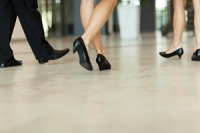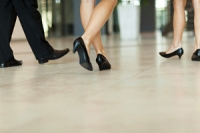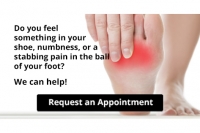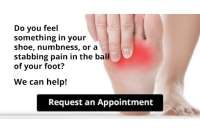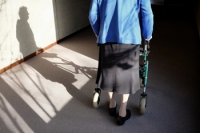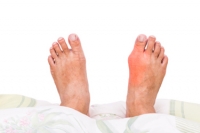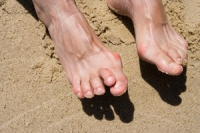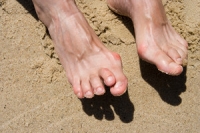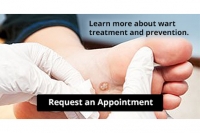
Blog (791)
Common Symptoms of Plantar Fasciitis
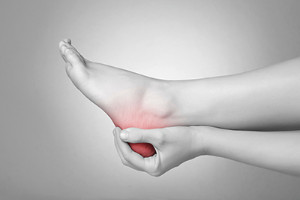 The band of tissue that connects the heel bone to the toes is known as the plantar fascia. If this tissue becomes inflamed, it’s likely the foot condition known as plantar fasciitis may develop. Plantar fasciitis can cause a great deal of heel pain for those affected. Early detection and prompt treatment can be helpful for a speedy recovery. There are a few signs to look out for if you believe you may have developed plantar fasciitis. If you are experiencing pain when you first step out of bed in the morning, when seated or standing for prolonged periods of time, or going up and down stairs, you may have plantar fasciitis. For a proper diagnosis and suggested plan of treatment, it’s suggested that you consult with a podiatrist.
The band of tissue that connects the heel bone to the toes is known as the plantar fascia. If this tissue becomes inflamed, it’s likely the foot condition known as plantar fasciitis may develop. Plantar fasciitis can cause a great deal of heel pain for those affected. Early detection and prompt treatment can be helpful for a speedy recovery. There are a few signs to look out for if you believe you may have developed plantar fasciitis. If you are experiencing pain when you first step out of bed in the morning, when seated or standing for prolonged periods of time, or going up and down stairs, you may have plantar fasciitis. For a proper diagnosis and suggested plan of treatment, it’s suggested that you consult with a podiatrist.
Plantar fasciitis can be very painful and inconvenient. If you are experiencing heel pain or symptoms of plantar fasciitis, contact Dr. Kenneth Donovan from Advanced Care Foot and Ankle. Our doctor can provide the care you need to keep you pain-free and on your feet.
What Is Plantar Fasciitis?
Plantar fasciitis is the inflammation of the thick band of tissue that runs along the bottom of your foot, known as the plantar fascia, and causes mild to severe heel pain.
What Causes Plantar Fasciitis?
- Excessive running
- Non-supportive shoes
- Overpronation
- Repeated stretching and tearing of the plantar fascia
How Can It Be Treated?
- Conservative measures – anti-inflammatories, ice packs, stretching exercises, physical therapy, orthotic devices
- Shockwave therapy – sound waves are sent to the affected area to facilitate healing and are usually used for chronic cases of plantar fasciitis
- Surgery – usually only used as a last resort when all else fails. The plantar fascia can be surgically detached from the heel
While very treatable, plantar fasciitis is definitely not something that should be ignored. Especially in severe cases, speaking to your doctor right away is highly recommended to avoid complications and severe heel pain. Your podiatrist can work with you to provide the appropriate treatment options tailored to your condition.
If you have any questions please feel free to contact one of our offices located in Warren, Livingston, and Toms River, NJ . We offer the newest diagnostic and treatment technologies for all your foot and ankle needs.
Wearing Shoes That Can Protect The Feet While Working
There are several types of jobs that require employees to stand for the majority of the day. This can cause the feet to become tired, and it is beneficial to take necessary precautions that can help the feet to feel good. These can include wearing appropriate shoes that have adequate cushioning and support. It is beneficial to choose a non-slip sole to maintain traction, in addition to wearing shoes that are made of breathable materials. Research has indicated it is important to frequently perform gentle foot stretches that may help the feet to become strong, and this may diminish existing aches and pains. For more information about how the feet are affected from standing for extended periods of time during the day, please confer with a podiatrist.
While working on the feet, it is important to take the proper care of them. For more information about working on your feet, contact Dr. Kenneth Donovan from Advanced Care Foot and Ankle. Our doctor will treat your foot and ankle needs.
Working on Your Feet
Standing on your feet for long periods of time can cause stress and pain in your feet. Your whole body may experience change in terms of posture, back pain, bunions, callouses and or plantar warts. There are ways to avoid these conditions with proper foot care, smart choices and correct posture.
Positive Changes
Negative heeled shoe – Choosing this shoe type places the heel slightly lower than the ball of the foot. These are great for overall foot health. Find shoes that fit you correctly.
Go barefoot – Our feet were not designed to be enclosed for all hours of the day. Try to periodically expose your feet to air.
Eliminate Pain
Foot Exercises – Performing simple exercises, incorporating yoga and doing stretches are beneficial. This will allow increased blood flow to the area and muscles of the foot.
Achilles tendon – Stretching the foot out flat on the floor will relax the calf muscles and tendon. These exercises can be performed almost anywhere. Make sure you add these exercises to your daily regimen.
With a little bit of this information and knowing more about foot health, you will notice changes. Foot stretches and proper footwear will help with pain and prevent further issues.
If you have any questions please feel free to contact one of our offices located in Warren, Livingston, and Toms River, NJ . We offer the newest diagnostic and treatment technologies for all your foot and ankle needs.
Wearing Shoes That Can Protect The Feet While Working
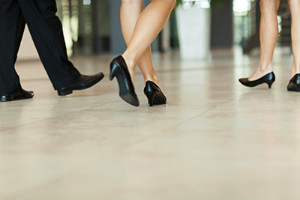 There are several types of jobs that require employees to stand for the majority of the day. This can cause the feet to become tired, and it is beneficial to take necessary precautions that can help the feet to feel good. These can include wearing appropriate shoes that have adequate cushioning and support. It is beneficial to choose a non-slip sole to maintain traction, in addition to wearing shoes that are made of breathable materials. Research has indicated it is important to frequently perform gentle foot stretches that may help the feet to become strong, and this may diminish existing aches and pains. For more information about how the feet are affected from standing for extended periods of time during the day, please confer with a podiatrist.
There are several types of jobs that require employees to stand for the majority of the day. This can cause the feet to become tired, and it is beneficial to take necessary precautions that can help the feet to feel good. These can include wearing appropriate shoes that have adequate cushioning and support. It is beneficial to choose a non-slip sole to maintain traction, in addition to wearing shoes that are made of breathable materials. Research has indicated it is important to frequently perform gentle foot stretches that may help the feet to become strong, and this may diminish existing aches and pains. For more information about how the feet are affected from standing for extended periods of time during the day, please confer with a podiatrist.
While working on the feet, it is important to take the proper care of them. For more information about working on your feet, contact Dr. Kenneth Donovan from Advanced Care Foot and Ankle. Our doctor will treat your foot and ankle needs.
Working on Your Feet
Standing on your feet for long periods of time can cause stress and pain in your feet. Your whole body may experience change in terms of posture, back pain, bunions, callouses and or plantar warts. There are ways to avoid these conditions with proper foot care, smart choices and correct posture.
Positive Changes
Negative heeled shoe – Choosing this shoe type places the heel slightly lower than the ball of the foot. These are great for overall foot health. Find shoes that fit you correctly.
Go barefoot – Our feet were not designed to be enclosed for all hours of the day. Try to periodically expose your feet to air.
Eliminate Pain
Foot Exercises – Performing simple exercises, incorporating yoga and doing stretches are beneficial. This will allow increased blood flow to the area and muscles of the foot.
Achilles tendon – Stretching the foot out flat on the floor will relax the calf muscles and tendon. These exercises can be performed almost anywhere. Make sure you add these exercises to your daily regimen.
With a little bit of this information and knowing more about foot health, you will notice changes. Foot stretches and proper footwear will help with pain and prevent further issues.
If you have any questions please feel free to contact one of our offices located in Warren, Livingston, and Toms River, NJ . We offer the newest diagnostic and treatment technologies for all your foot and ankle needs.
Why Live with Pain and Numbness in Your Feet?
Why Live with Pain and Numbness in Your Feet?
How Exercise May Help to Prevent Falling
It is beneficial for elderly people to get routine medical examinations throughout the year. This may be helpful in preventing falling episodes, which can be a common occurrence among seniors. Existing medication can be reviewed, in addition to ensuring the legs maintain the strength that is needed to complete daily activities. Performing a gentle exercise and stretching routine may help the body to become stronger, and this often helps to increase flexibility. Additionally, the living environment may have to be readjusted. This can include improving the lighting, removing torn rugs, and installing grab bars in the shower and toilet area. It is important to know how falling may impact the feet, and if you would like more information about how to prevent falling, please schedule an appointment with a podiatrist.
Preventing falls among the elderly is very important. If you are older and have fallen or fear that you are prone to falling, consult with Dr. Kenneth Donovan from Advanced Care Foot and Ankle. Our doctor will assess your condition and provide you with quality advice and care.
Every 11 seconds, an elderly American is being treated in an emergency room for a fall related injury. Falls are the leading cause of head and hip injuries for those 65 and older. Due to decreases in strength, balance, senses, and lack of awareness, elderly persons are very susceptible to falling. Thankfully, there are a number of things older persons can do to prevent falls.
How to Prevent Falls
Some effective methods that older persons can do to prevent falls include:
- Enrolling in strength and balance exercise program to increase balance and strength
- Periodically having your sight and hearing checked
- Discuss any medications you have with a doctor to see if it increases the risk of falling
- Clearing the house of falling hazards and installing devices like grab bars and railings
- Utilizing a walker or cane
- Wearing shoes that provide good support and cushioning
- Talking to family members about falling and increasing awareness
Falling can be a traumatic and embarrassing experience for elderly persons; this can make them less willing to leave the house, and less willing to talk to someone about their fears of falling. Doing such things, however, will increase the likelihood of tripping or losing one’s balance. Knowing the causes of falling and how to prevent them is the best way to mitigate the risk of serious injury.
If you have any questions, please feel free to contact one of our offices located in Warren, Livingston, and Toms River, NJ . We offer the newest diagnostic and treatment technologies for all your foot care needs.
What Can Cause Gout?
Severe pain in the big toe is a common symptom of gout. It is a form of arthritis that attacks the joints in the toes, and additional signs of this condition can include swelling and redness. The risk of getting gout may be increased by having existing medical ailments that can include diabetes, hypertension, and obesity. Outside influences may consist of genetic factors, eating foods that have high purine levels, and drinking excess alcohol. Gout attacks may be prevented by eating healthy foods, and incorporating a gentle exercise program into your daily routine. It is important to drink plenty of water daily, as this may help to lower uric acid levels that can cause gout. If you are afflicted with gout, it is suggested that you are under the care of a podiatrist who can help you to manage this condition.
Gout is a painful condition that can be treated. If you are seeking treatment, contact Dr. Kenneth Donovan from Advanced Care Foot and Ankle. Our doctor will treat your foot and ankle needs.
What Is Gout?
Gout is a form of arthritis that is characterized by sudden, severe attacks of pain, redness, and tenderness in the joints. The condition usually affects the joint at the base of the big toe. A gout attack can occur at any random time, such as the middle of the night while you are asleep.
Symptoms
- Intense Joint Pain – Usually around the large joint of your big toe, and it most severe within the first four to twelve hours
- Lingering Discomfort – Joint discomfort may last from a few days to a few weeks
- Inflammation and Redness -Affected joints may become swollen, tender, warm and red
- Limited Range of Motion – May experience a decrease in joint mobility
Risk Factors
- Genetics – If family members have gout, you’re more likely to have it
- Medications – Diuretic medications can raise uric acid levels
- Gender/Age – Gout is more common in men until the age of 60. It is believed that estrogen protects women until that point
- Diet – Eating red meat and shellfish increases your risk
- Alcohol – Having more than two alcoholic drinks per day increases your risk
- Obesity – Obese people are at a higher risk for gout
Prior to visiting your podiatrist to receive treatment for gout, there are a few things you should do beforehand. If you have gout you should write down your symptoms–including when they started and how often you experience them, important medical information you may have, and any questions you may have. Writing down these three things will help your podiatrist in assessing your specific situation so that he or she may provide the best route of treatment for you.
If you have any questions, please feel free to contact one of our offices located in Warren, Livingston, and Toms River, NJ . We offer the newest diagnostic and treatment technologies for all your foot care needs.
What Is a Hammertoe?
The uncomfortable foot condition that is known as a hammertoe is considered to be a foot deformity. It can occur from genetic factors, or from wearing shoes that do not have adequate room for the toes to move freely in. The joints in the middle toes are typically affected, and can bend downward, which may resemble a hammer. Some patients have calluses that develop on top of the toes, and this may be a result of the toes rubbing against the top of the shoe. It may be beneficial to cease wearing pointed shoes such as high heels. Additionally, mild relief may be found when a protective pad is worn on the impacted toe. Severe hammertoes may cause pain and discomfort, and surgery may be a viable option to permanently straighten the toes. If you are afflicted with a hammertoe, it is suggested that you consult with a podiatrist as quickly as possible who can guide you toward the treatment that is best for you.
Hammertoe
Hammertoes can be a painful condition to live with. For more information, contact Dr. Kenneth Donovan from Advanced Care Foot and Ankle. Our doctor will answer any of your foot- and ankle-related questions.
Hammertoe is a foot deformity that affects the joints of the second, third, fourth, or fifth toes of your feet. It is a painful foot condition in which these toes curl and arch up, which can often lead to pain when wearing footwear.
Symptoms
- Pain in the affected toes
- Development of corns or calluses due to friction
- Inflammation
- Redness
- Contracture of the toes
Causes
Genetics – People who are genetically predisposed to hammertoe are often more susceptible
Arthritis – Because arthritis affects the joints in your toes, further deformities stemming from arthritis can occur
Trauma – Direct trauma to the toes could potentially lead to hammertoe
Ill-fitting shoes – Undue pressure on the front of the toes from ill-fitting shoes can potentially lead to the development of hammertoe
Treatment
Orthotics – Custom made inserts can be used to help relieve pressure placed on the toes and therefore relieve some of the pain associated with it
Medications – Oral medications such as anti-inflammatories or NSAIDs could be used to treat the pain and inflammation hammertoes causes. Injections of corticosteroids are also sometimes used
Surgery – In more severe cases where the hammertoes have become more rigid, foot surgery is a potential option
If you have any questions please contact one of our offices located in Warren, Livingston, and Toms River, NJ . We offer the newest diagnostic and treatment technologies for all your foot and ankle needs.
What Is a Hammertoe?
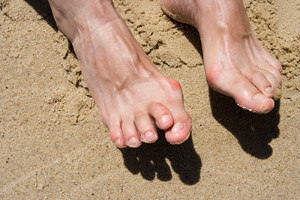 The uncomfortable foot condition that is known as a hammertoe is considered to be a foot deformity. It can occur from genetic factors, or from wearing shoes that do not have adequate room for the toes to move freely in. The joints in the middle toes are typically affected, and can bend downward, which may resemble a hammer. Some patients have calluses that develop on top of the toes, and this may be a result of the toes rubbing against the top of the shoe. It may be beneficial to cease wearing pointed shoes such as high heels. Additionally, mild relief may be found when a protective pad is worn on the impacted toe. Severe hammertoes may cause pain and discomfort, and surgery may be a viable option to permanently straighten the toes. If you are afflicted with a hammertoe, it is suggested that you consult with a podiatrist as quickly as possible who can guide you toward the treatment that is best for you.
The uncomfortable foot condition that is known as a hammertoe is considered to be a foot deformity. It can occur from genetic factors, or from wearing shoes that do not have adequate room for the toes to move freely in. The joints in the middle toes are typically affected, and can bend downward, which may resemble a hammer. Some patients have calluses that develop on top of the toes, and this may be a result of the toes rubbing against the top of the shoe. It may be beneficial to cease wearing pointed shoes such as high heels. Additionally, mild relief may be found when a protective pad is worn on the impacted toe. Severe hammertoes may cause pain and discomfort, and surgery may be a viable option to permanently straighten the toes. If you are afflicted with a hammertoe, it is suggested that you consult with a podiatrist as quickly as possible who can guide you toward the treatment that is best for you.
Hammertoe
Hammertoes can be a painful condition to live with. For more information, contact Dr. Kenneth Donovan from Advanced Care Foot and Ankle. Our doctor will answer any of your foot- and ankle-related questions.
Hammertoe is a foot deformity that affects the joints of the second, third, fourth, or fifth toes of your feet. It is a painful foot condition in which these toes curl and arch up, which can often lead to pain when wearing footwear.
Symptoms
- Pain in the affected toes
- Development of corns or calluses due to friction
- Inflammation
- Redness
- Contracture of the toes
Causes
Genetics – People who are genetically predisposed to hammertoe are often more susceptible
Arthritis – Because arthritis affects the joints in your toes, further deformities stemming from arthritis can occur
Trauma – Direct trauma to the toes could potentially lead to hammertoe
Ill-fitting shoes – Undue pressure on the front of the toes from ill-fitting shoes can potentially lead to the development of hammertoe
Treatment
Orthotics – Custom made inserts can be used to help relieve pressure placed on the toes and therefore relieve some of the pain associated with it
Medications – Oral medications such as anti-inflammatories or NSAIDs could be used to treat the pain and inflammation hammertoes causes. Injections of corticosteroids are also sometimes used
Surgery – In more severe cases where the hammertoes have become more rigid, foot surgery is a potential option
If you have any questions please contact one of our offices located in Warren, Livingston, and Toms River, NJ . We offer the newest diagnostic and treatment technologies for all your foot and ankle needs.

